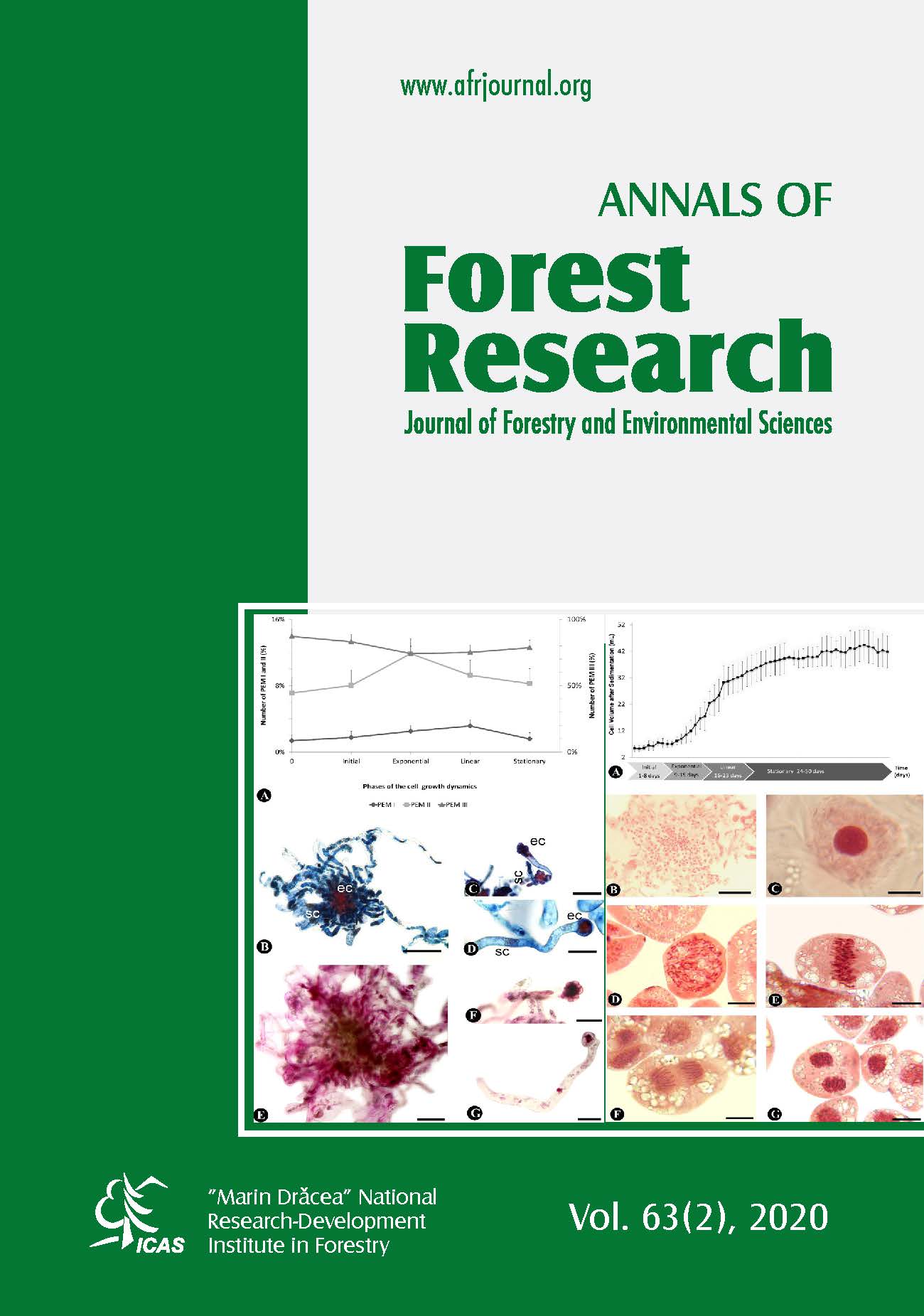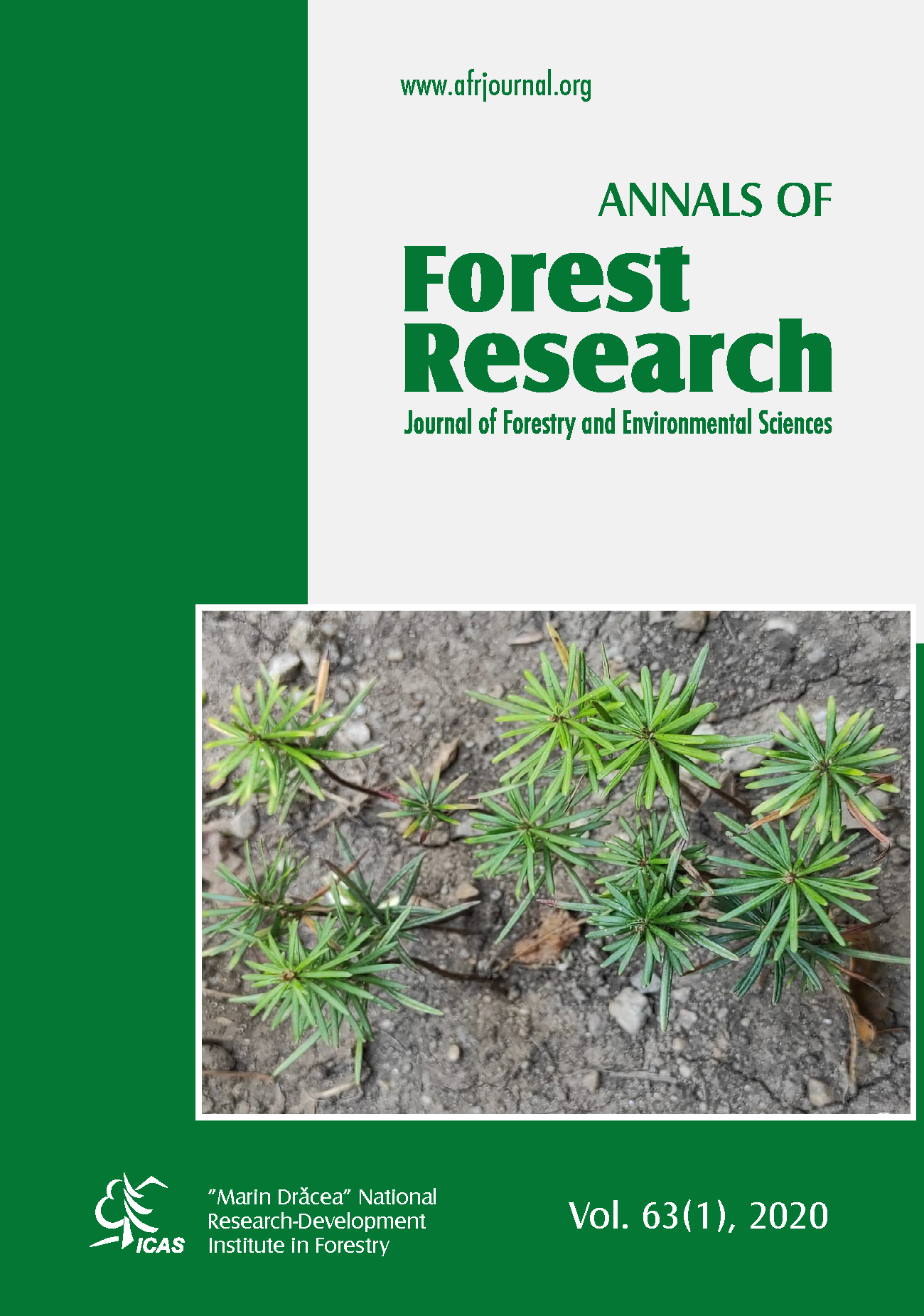Structural heterogeneity and old-growthness: A first regional-scale assessment of Sardinian forests
DOI:
https://doi.org/10.15287/afr.2020.1968Keywords:
old-growth forests, forest ecosystems conservation, Mediterranean Basin, Structural Heterogeneity IndexAbstract
Mediterranean forests have been altered by several human activities. Consequently, relatively intact forests that have been unmodified by humans for a relatively long time (i.e., old-growth forests) are often reduced to isolated and fragmented stands. However, despite their high conservation value, little is known about their features and even presence several Mediterranean areas. First steps of their investigation are based on the identification of old-growth features such as amount of large‐size and old trees, tree species composition, canopy heterogeneity, occurrence and amount of deadwood. The Structural Heterogeneity Index (SHI) is commonly used to summarise features of old-growthness in one single value. Here, the SHI was derived for 68 plots included in 45 forest stands within the 4,297 km2 of territory that is covered by forests in Sardinia. SHI values were affected by variables that are likely to be related to forest age and structural complexity, such as presence of cerambycids, canopy cover, forest layers, location and three old-growthness classes. Results confirm a high structural variability among forests with old-growth features, determined by the presence, or lack, of given living and deadwood features. Our findings identified, for the first time, most of the forest stands that need special protection in Sardinia for the presence of old-growth features. In this sense, the SHI was confirmed useful for improving their management and conservation, although more specific and deeper studies are necessary for better understanding their species composition and dynamics.References
Abadie J., Avon C., Dupouey J. L., Lopez J. M., Tatoni T., Bergès, L., 2018. Land use legacies on forest understory vegetation and soils in the Mediterranean region: Should we use historical maps or in situ land use remnants? For. Ecol. Manag. 427: 17–25. DOI: 10.1016/j.foreco.2018.05.050Amici V., Santi E., Filibeck G., Diekmann M., Geri F., Landi S., Scoppola A., Chiarucci A., 2013. Influence of secondary forest succession on plant diversity patterns in a Mediterranean landscape. J. Biogeogr. 40: 2335–2347. DOI: 10.1111/jbi.12182Arar A., Nouidjem Y., Bounar R., Tabet S., Kouba Y., 2020. Modeling of the current and future potential distribution of Atlas cedar (Cedrus atlantica) forests revealed shifts in the latitudinal, longitudinal and altitudinal range towards more humid conditions. Ecol. Quest. 31: 1–22. DOI: 10.12775/29839Bacchetta G., Bagella S., Biondi E., Farris E., Filigheddu R.S., Mossa L., 2009. Vegetazione forestale e serie di vegetazione della Sardegna (con rappresentazione cartografica alla scala 1: 350.000) [Forest vegetation and vegetation series of Sardinia (at the resolution of 1: 350,000]. Società Italiana di Fitosociologia 46: 1–82.Bacchetta G., Bagella S., Biondi E., Filigheddu R., Farris E., Mossa L., 2004a. A contribution to the knowledge of the order Quercetalia ilicis Br.-Bl. ex Molinier 1934 of Sardinia. Fitosociologia 41: 29–51.Bacchetta G., Biondi E., Filigheddu R., Farris E., Mossa L., 2004b. A phytosociological study of the deciduous oak woods of Sardinia (Italy). Fitosociologia 41: 53–65.Badalamenti E., Pasta S., La Mantia T., La Mela Veca D.S., 2018. Criteria to identify old‐growth forests in the Mediterranean: A case study from Sicily based on literature review and some management proposals. Feddes Repertorium 129: 25–37. DOI: 10.1002/fedr.201700009Bergmeier E., Petermann J., Schröder E., 2010. Geobotanical survey of wood-pasture habitats in Europe: diversity, threats and conservation. Biodivers. Conserv. 19: 2995–3014. DOI: 10.1007/s10531-010-9872-3Bernicchia A., Benni A., Venturella G., Gargano M.L., Saitta A., Gorjón S.P. 2008. Aphyllophoraceous wood-inhabiting fungi on Quercus spp. in Italy. Mycotaxon 104: 425–428.Biondi M., Urbani F., D’Alessandro P., 2013. Endemism patterns in the Italian leaf beetle fauna (Coleoptera, Chrysomelidae). ZooKeys 332: 177. DOI: 10.3897/zookeys.332.5339Blasi C., Marchetti M., Chiavetta U., Aleffi M., Audisio P., Azzella M.M., Brunialti G., Capotorti G., Del Vico E., Lattanzi E., Persiani A.M., Ravera S., Tilia A., Burrascano S., 2010. Multi‐taxon and forest structure sampling for identification of indicators and monitoring of old‐growth forest. Plant Biosyst. 144: 160–170. DOI: 10.1080/11263500903560538Błonska E., Lasota J., da Silva G.R.V., Vanguelova E., Ashwood F., Tibbett M., Watts K., Lukac, M., 2020. Soil organic matter stabilization and carbon-cycling enzyme activity are affected by land management. Ann. For. Res. 63: 71–86. DOI: 10.15287/afr.2019.1837Brunialti G., Frati L., Aleffi M., Marignani M., Rosati L., Burrascano S., Ravera, S., 2010. Lichens and bryophytes as indicators of old growth features in Mediterranean forests. Plant Biosyst. 144: 221–233. DOI: 10.1080/11263500903560959Buchwald E., 2005. A hierarchical terminology for more or less natural forests in relation to sustainable management and biodiversity conservation. In Proceedings: Third expert meeting on harmonizing forest-related definitions for use by various stakeholders. Proceedings. Food and Agriculture Organization of the United Nations, Rome (pp. 17–19).Burrascano S., Rosati L., Blasi C., 2009. Plant species diversity in Mediterranean old-growth forests: a case study from central Italy. Plant Biosyst. 143: 190–200. DOI: 10.1080/11263500802709699Burrascano S., 2010. On the terms used to refer to ‘natural’ forests: a response to Veen et al. Biodivers. Conserv. 19: 3301–3305. DOI: 10.1007/s10531-010-9885-yBurrascano S., Ripullone F., Bernardo L., Borghetti M., Carli E., Colangelo M., Pelle L, Rivelli A. R., Sabatini F. M., Schettino A., Siclari A., Uzunov D., Blasi C., 2018. It's a long way to the top: Plant species diversity in the transition from managed to old‐growth forests. J. Veg. Sci. 29: 98–109.Buse J., Ranius T., Assmann T., 2008. An endangered longhorn beetle associated with old oaks and its possible role as an ecosystem engineer. Conserv. Biol. 22: 329–337. DOI: 10.1111/j.1523-1739.2007.00880.xCampetella G., Canullo R., Gimona A., Garadnai J., Chiarucci A., Giorgini D., Angelini E., Cervellini M., Chelli S., Bartha S., 2016. Scale‐dependent effects of coppicing on the species pool of late successional beech forests in the central Apennines, Italy. Appl. Veg. Sci. 19: 474–485. DOI: 10.1111/avsc.12235Cardil A., Salis M., Spano D., Delogu G., Molina Terren D., 2014. Large wildland fires and extreme temperatures in Sardinia (Italy). iForest 7: 162. DOI: 10.3832/ifor1090-007Casula P., 2017. Monitoring and management of Cerambyx cerdo in the Mediterranean region–a review and the potential role of citizen science. Nat. Conservation 19: 97. DOI: 10.3897/natureconservation.19.12637Caterini F., 2013. Colpi di scure e sensi di colpa: storia del disboscamento della Sardegna dalle origini a oggi [Hits of axes and feelings of guilt: history of deforestation of Sardinia from its origins to today]. Delfino Editore, Sassari.Chiavetta L., Sallustio V., Garfi M., Maesano M., Marchetti M., 2012. Classification of the oldgrowthness of forest inventory plots with dissimilarity metrics in Italian National Parks. Eur. J. For. Res. 131: 1473–1483. DOI: 10.1007/s10342-012-0622-9.Chirici, G., Nocentini, S.,2013. Old-growth forests in Italy: recent research developments and future perspectives. Ital. J. For. Mt. Environ. 65: 475–480. DOI: 10.4129/ifm.2010.5.01Diaci J., Rozenbergar D., Boncina A. 2010. Stand dynamics of Dinaric old‐growth forest in Slovenia: Are indirect human influences relevant? Plant Biosyst. 144: 194–201. DOI: 10.1080/11263500903560785FAO-Forest Resource Assessment (FRA), 2015 Terms and Definitions, 2012. Forest Resources Assessment Working Paper 180. Rome: Food and Agriculture Organization of the United Nations http://www.fao.org/3/ap862e/ap862e00.pdfFarris, E., Fenu, G., Bacchetta, G., 2012. Mediterranean Taxus baccata woodlands in Sardinia: a characterization of the EU priority habitat 9580. Phytocoenologia, 41: 231–246. DOI: 10.1127/0340-269X/2011/0041-0501Fedrowitz K., Koricheva J., Baker S.C., Lindenmayer D.B., Palik B., Rosenvald R., Beese W., Franklin F., Kaouki J., Macdonald E., Messier C., Sverdup-Thygeson A., Gustafsson L., 2014. Can retention forestry help conserve biodiversity? A meta‐analysis. J. Appl. Ecol. 51: 1669–1679. DOI:10.1111/1365-2664.12289Fenu G., Fois M., Cañadas E.M., Bacchetta G., 2014. Using endemic-plant distribution, geology and geomorphology in biogeography: the case of Sardinia (Mediterranean Basin). Syst. Biodivers.12: 181–193. DOI: 10.1080/14772000.2014.894592Fois M., Fenu G., Bacchetta G., 2018. Identifying and assessing the efficiency of different networks of a fine-scale hierarchy of biodiversity hotspots. Plant Ecol. Divers. 11: 121–132. DOI:10.1080/17550874.2018.1474281Fois M., Fenu G., Bacchetta G., 2019. Estimating land market values from real estate offers: A replicable method in support of biodiversity conservation strategies. Ambio 48, 313–323. DOI: 10.1007/s13280-018-1074-3Fois M., Fenu G., Cañadas E. M., Bacchetta G., 2017. Disentangling the influence of environmental and anthropogenic factors on the distribution of endemic vascular plants in Sardinia. PloS one 12: e0182539. DOI: 10.1371/journal.pone.0182539Fortuny X., Carcaillet C., Chauchard S., 2020. Selective and taxon-dependent effects of semi-feral cattle grazing on tree regeneration in an old-growth Mediterranean mountain forest. For. Ecosyst. 7: 1–13. DOI: 10.1186/s40663-020-00222-7Franklin J. F., Van Pelt R., 2004. Spatial aspects of structural complexity in old-growth forests. J. Forestry. 102(3): 22–28. DOI: 10.1093/jof/102.3.22Fridman J., Walheim M., 2000. Amount, structure, and dynamics of dead wood on managed forestland in Sweden. For. Ecol. Manag. 131: 23–36. DOI: 10.1016/S0378-1127(99)00208-XGasparini P., Di Cosmo L., Floris A., Notarangelo G., Rizzo M., 2016. Guida per i rilievi in campo. INFC2015 – Terzo inventario forestale nazionale [Guidelines for field inventories – Third national inventory]. Consiglio per la ricerca in agricoltura e l’analisi dell’economia agraria, Unità di Ricerca per il Monitoraggio e la Pianificazione Forestale (CREA-MPF); Corpo Forestale dello Stato, Ministero per le Politiche Agricole, Alimentari e Forestali. 341 pp. https://inventarioforestale.org (accessed 03November 2019).Gauquelin T., Bertaudiere V., Montes N., Badri W., Asmode J. F., 1999. Endangered stands of thuriferous juniper in the western Mediterranean basin. Biodivers. Conserv. 8: 1479–1498. DOI: 10.1023/A:1008966808796Gauquelin T., Michon G., Joffre R., Duponnois R., Génin D., Fady B., Alifriqui M., Auclair L., Simenel R., Aderghal M., Baudoin E., Galiana A., Prin Y., Sanguin H., Fernandez C., Baldy V., 2018. Mediterranean forests, land use and climate change: a social-ecological perspective. Reg. Environ. Change 18: 623–636. DOI: 10.1007/s10113-016-0994-3Gauthier S., Leduc A., Bergeron Y., 1996. Forest dynamics modelling under natural fire cycles: a tool to define natural mosaic diversity for forest management. Environ. Monit. Assess. 39: 417–434. DOI: 10.1007/BF00396159Grove A.T., Rackham, O., 2003. The nature of Mediterranean Europe: an ecological history. Yale University Press. London.Heatherington T., 2001. Ecology, alterity and resistance in Sardinia. Soc. Anthropology 9: 289–306. DOI: 10.1111/j.1469-8676.2001.tb00154.xHunter Jr M.L., 1990. Wildlife, forests, and forestry. Principles of managing forests for biological diversity. Prentice Hall. Englewood Cliffs, New Jersey USAISTAT, 2019. Istituto nazionale di statistica - Roma. https://www.istat.it/itJanssen P., Fortin D., Hébert C., 2009. Beetle diversity in a matrix of old‐growth boreal forest: influence of habitat heterogeneity at multiple scales. Ecography 32: 423–-432. DOI: 10.1111/j.1600-0587.2008.05671.xJennings S.B., Brown N.D., Sheil D., 1999. Assessing forest canopies and understorey illumination: canopy closure, canopy cover and other measures. Forestry 72: 59–74. DOI: 10.1093/forestry/72.1.59Johansen K., Coops N.C., Gergel S.E., Stange Y., 2007. Application of high spatial resolution satellite imagery for riparian and forest ecosystem classification. Remote Sens. Environ. 110: 29–44. DOI: 10.1016/j.rse.2007.02.014Kaňuch P., Danko Š., Celuch M., Krištín A., Pjenčák P., Matis Š., Šmídt J., 2008. Relating bat species presence to habitat features in natural forests of Slovakia (Central Europe). Mamm. Biol. 73: 147–155. DOI: 10.1016/j.mambio.2006.12.001Kaplan J. O., Krumhardt K. M., Zimmermann N., 2009. The prehistoric and preindustrial deforestation of Europe. Quaternary Science Reviews 28: 3016–3034. DOI: 10.1016/j.quascirev.2009.09.028Kassambara A., Mundt F., 2017. Package ‘factoextra’. Extract and visualize the results of multivariate data analyses, 76. http://www.sthda.com/english/rpkgs/factoextraLe S., Josse J., Husson F., 2008. FactoMineR: An R package for multivariate analysis. J. Stat. Softw. 25: 1–18. http://www.jstatsoft.org/v25/i01/Lesica P., McCune B., Cooper S.V., Hong W.S., 1991. Differences in lichen and bryophyte communities between old-growth and managed second-growth forests in the Swan Valley, Montana. Can. J. Botany. 69: 1745–1755. DOI: 10.1139/b91-222Lindenmayer D.B., Cunningham R.B., Donnelly C.F., Franklin J.F., 2000. Structural features of old-growth Australian montane ash forests. For. Ecol.Manag. 134: 189–204. DOI: 10.1016/S0378-1127(99)00257-1Lombardi F., Chirici G., Marchetti M., Tognetti R., Lasserre B., Corona P., Barbati A., Ferrari B., Di Paolo S., Giuliarelli D., Mason F., Iovino F., Nicolaci A., Bianchi L., Maltoni A., Travaglini D., 2013. Deadwood in forest stands close to old-growthness under Mediterranean conditions in the Italian Peninsula. Ital. J. For. Mount. Environ. 65: 481–504. DOI: 10.4129/ifm.2010.5.02Lombardi F., Marchetti M., Corona P., Merlini P., Chirici G., Tognetti R., Burrascano S., Alivernini A., Puletti N., 2015. Quantifying the effect of sampling plot size on the estimation of structural indicators in old-growth forest stands. For. Ecol. Manag. 346: 89–97. DOI: 10.1016/j.foreco.2015.02.011Marchetti M., Tognetti R., Lombardi F., Chiavetta U., Palumbo G., Sellitto M., Colombo C., Iovieno P., Alfani A., Baldantoni D., Barbati A., Ferrari B., Bonacquisti S., Capotorti G., Copiz R., Blasi C., 2010. Ecological portrayal of old‐growth forests and persistent woodlands in the Cilento and Vallo di Diano National Park (southern Italy). Plant Biosyst. 144: 130–147. DOI: 10.1080/11263500903560470Mayor A.G., Bautista S., Llovet J., Bellot J., 2007. Post-fire hydrological and erosional responses of a Mediterranean landscape: Seven years of catchment-scale dynamics. Catena 71: 68–75. DOI: 10.1016/j.catena.2006.10.006McElhinny C., Gibbons P., Brack C., 2006. An objective and quantitative methodology for constructing an index of stand structural complexity. For. Ecol. Manag. 235: 54–71. DOI: 10.1016/j.foreco.2006.07.024McElhinny C., Gibbons P., Brack C., Bauhus J., 2005. Forest and woodland stand structural complexity: its definition and measurement. For. Ecol. Manag. 218: 1–24. DOI: 10.1016/j.foreco.2005.08.034Motta R., 2002. Old-growth forests and silviculture in the Italian Alps: the case-study of the strict reserve of Paneveggio (TN). Plant Biosyst. 136: 223–231. DOI: 10.1080/11263500212331351129Motta R., Garbarino M., Berretti R., Bjelanovic I., Borgogno Mondino E., Čurović M., Keren S., Meloni F., Nosenzo A., 2015. Structure, spatio‐temporal dynamics and disturbance regime of the mixed beech–silver fir–Norway spruce old‐growth forest of Biogradska Gora (Montenegro). Plant Biosyst. 149: 966–975. DOI: 10.1080/11263504.2014Mucedda M., Kiefer A., Pidinchedda E., Veith M., 2002. A new species of long-eared bat (Chiroptera, Vespertilionidae) from Sardinia (Italy). Acta Chiropt. 4: 121–135. DOI: 10.3161/001.004.0202Ódor P., Standovár T., 2001. Richness of bryophyte vegetation in near-natural and managed beech stands: the effects of management-induced differences in dead wood. Ecol. Bull. 49: 219–229. https://www.jstor.org/stable/20113278Ohlson M., Söderström L., Hörnberg G., Zackrisson O., Hermansson J., 1997. Habitat qualities versus long-term continuity as determinants of biodiversity in boreal old-growth swamp forests. Biol. Conserv. 81: 221–231. DOI: 10.1016/S0006-3207(97)00001-3Paillet Y., Berges L., Hjalten J., Ódor P., Avon C., Bernhardt‐Romermann M., Bijlsma R., De Bruyn L., Fuhr M., Grandin U., et al., 2010. Biodiversity differences between managed and unmanaged forests: Meta‐analysis of species richness in Europe. Conserv. Biol. 24: 101–112. DOI: 10.1111/j.1523-1739.2009.01399.xParisi F., Lombardi F., Sciarretta A., Tognetti R., Campanaro A., Marchetti M., Trematerra P., 2016. Spatial patterns of saproxylic beetles in a relic silver fir forest (Central Italy), relationships with forest structure and biodiversity indicators. For. Ecol. Manag. 381: 217–234. DOI: 10.1016/j.foreco.2016.09.041Parkes D., Newell G., Cheal D., 2003. Assessing the quality of native vegetation: the ‘habitat hectares’ approach. Ecol. Manag. Restor. 4: 29–38. DOI: 10.1046/j.1442-8903.4.s.4.xParviainen J., 2005. Virgin and natural forests in the temperate zone of Europe. For. Snow Landsc. Res. 79: 9–18.Puddu G., Falcucci A., Maiorano L., 2012. Forest changes over a century in Sardinia: implications for conservation in a Mediterranean hotspot. Agroforest. Syst. 85: 319–330. DOI: 10.1007/s10457-011-9443-yPungetti G., 1995. Anthropological approach to agricultural landscape history in Sardinia. Landscape Urban Plan. 31: 47–56. DOI: 10.1016/0169-2046(94)01035-7R Core Team, 2018. R: A language and environment for statistical computing. Version 3.6.1 R Core Team, R Foundation for Statistical Computing, Vienna, Austria.https://CRAN.R-project.orgRichard F., Moreau P.A., Selosse M.A., Gardes M., 2004. Diversity and fruiting patterns of ectomycorrhizal and saprobic fungi in an old-growth Mediterranean forest dominated by Quercus ilex L. Can. J. Bot. 82: 1711–1729. DOI: 10.1139/b04-128Rozas V., 2006. Structural heterogeneity and tree spatial patterns in an old-growth deciduous lowland forest in Cantabria, northern Spain. Plant Ecol. 185: 57–72. DOI: 10.1007/s11258-005-9084-1Sabatini F. M., Burrascano S., Lombardi F., Chirici G., Blasi C., 2015. An index of structural complexity for Apennine beech forests. iForest 8: 314. DOI: 10.3832/ifor1160-008Sabatini F.M., Burrascano S., Keeton W.S., Levers C., Lindner M., Pötzschner F., Verkerk P.J., Bauhus J., Buchwald, E., Chaskovsky, O. …, Kuemmerle T., 2018. Where are Europe’s last primary forests? Divers. Distrib. 24: 1426–1439. DOI: 10.1111/ddi.12778Scotti R., Cadoni M., 2007. A historical analysis of traditional common forest planning and management in Seneghe, Sardinia—lessons for sustainable development. For. Ecol. Manag. 249: 116–124. DOI: 10.1016/j.foreco.2007.05.027Storch F., Dormann C.F., Bauhus J., 2018. Quantifying forest structural diversity based on large-scale inventory data: a new approach to support biodiversity monitoring. For. Ecosyst. 5: 34. DOI: 10.1186/s40663-018-0151-1Vicol I., 2016. Effect of old‐growth forest attributes on lichen species abundances: A study performed within Ceahlău National Park (Romania). Cryptogamie, Mycologie 36: 399–407. DOI: 10.7872/crym/v36.iss4.2015.399Zenner E.K., 2004. Does old-growth condition imply high live-tree structural complexity? For. Ecol. Manag. 195: 243–258. DOI: 10.1016/j.agrformet.2017.04.012Ziaco E., Di Filippo A., Alessandrini A., Baliva M., D'Andrea E., Piovesan G., 2012. Old-growth attributes in a network of Apennines (Italy) beech forests: disentangling the role of past human interferences and biogeoclimate. Plant Biosyst. 146: 153–166. DOI: 10.1080/11263504.2011.650729
Downloads
Published
Issue
Section
License
All the papers published in Annals of Forest Research are available under an open access policy (Gratis Gold Open Access Licence), which guaranty the free (of taxes) and unlimited access, for anyone, to entire content of the all published articles. The users are free to “read, copy, distribute, print, search or refers to the full text of these articles”, as long they mention the source.
The other materials (texts, images, graphical elements presented on the Website) are protected by copyright.
The journal exerts a permanent quality check, based on an established protocol for publishing the manuscripts. The potential article to be published are evaluated (peer-review) by members of the Editorial Board or other collaborators with competences on the paper topics. The publishing of manuscript is free of charge, all the costs being supported by Forest Research and Management Institute.
More details about Open Access:
Wikipedia: http://en.wikipedia.org/wiki/Open_access





